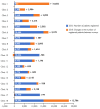Are Family Medicine Clinics Improving Access to Care through Organizational Changes Driven by Healthcare Reform?
- PMID: 36103237
- PMCID: PMC9467270
- DOI: 10.12927/hcpol.2022.26905
Are Family Medicine Clinics Improving Access to Care through Organizational Changes Driven by Healthcare Reform?
Abstract
Purpose: This observational descriptive study reports organizational changes after the last reform in 18 family medicine units (FMUs) affiliated with the University of Montreal in Québec.
Method: Two self-administered surveys on access to care were administered to FMU directors between December 2016 and January 2017, and in August 2018.
Results: Between surveys, the number of registered patients increased substantially. All clinics recruited new patients, and most offered walk-in services (89%) and moved toward an advanced access scheduling model (83%). For licensed practical nurses, there was a median increase from 0 to 3 and for nurse clinicians, from 2 to 3, that helped the development of collaborative teamwork.
Conclusion: Despite the added teaching mission, the response of the FMU network has been dynamic, has adapted to the major changes and has continued to actively improve access to care for their communities. Challenges still remain regarding work on key priorities for improving access management.
Objectif:: Cette étude descriptive observationnelle fait état des changements organisationnels, après la dernière réforme, dans 18 unités de médecine de famille (UMFs) affiliées à l'Université de Montréal au Québec.
Méthode:: Deux questionnaires auto-administrés sur l'accès aux soins ont été soumis aux directeurs des UMFs entre décembre 2016 et janvier 2017, et en août 2018.
Résultats:: Entre les deux questionnaires, le nombre de patients inscrits a considérablement augmenté. Toutes les cliniques ont recruté de nouveaux patients et la plupart ont offert des services sans rendez-vous (89 %) et ont adopté un modèle avancé pour la planification de l'accès (83 %). Il y a eu une augmentation médiane de 0 à 3 des infirmières auxiliaires et de 2 à 3 des infirmières cliniciennes, ce qui a favorisé le développement du travail d'équipe collaboratif.
Conclusion:: Malgré la mission d'enseignement supplémentaire, la réaction du réseau des UMFs a été dynamique, s'est adaptée aux changements majeurs et a permis d'améliorer activement l'accès aux soins pour les communautés concernées. Il reste des défis quant aux priorités clés pour améliorer la gestion de l'accès.
Copyright © 2022 Longwoods Publishing.
Figures
Similar articles
-
Evaluation of the implementation and associated effects of advanced access in university family medicine groups: a study protocol.BMC Fam Pract. 2020 Feb 21;21(1):41. doi: 10.1186/s12875-020-01109-w. BMC Fam Pract. 2020. PMID: 32085728 Free PMC article.
-
Implementing advanced access to primary care in an academic family medicine network: Participatory action research.Can Fam Physician. 2019 Sep;65(9):641-647. Can Fam Physician. 2019. PMID: 31515315 Free PMC article.
-
Patients' perceptions of the quality of care after primary care reform: Family medicine groups in Quebec.Can Fam Physician. 2010 Jul;56(7):e273-82. Can Fam Physician. 2010. PMID: 20631263 Free PMC article.
-
Collaborative practice in health systems change: the Nova Scotia experience with the Strengthening Primary Care Initiative.Nurs Leadersh (Tor Ont). 2004 May;17(2):33-45. doi: 10.12927/cjnl.2004.16345. Nurs Leadersh (Tor Ont). 2004. PMID: 15239315 Review.
-
Advanced practice nursing after health care reform.Nurs Econ. 1995 Mar-Apr;13(2):84-8, 98. Nurs Econ. 1995. PMID: 7760962 Review.
Cited by
-
Provincial Health Systems: Are They Imploding?Healthc Policy. 2022 Aug;18(1):6-16. doi: 10.12927/hcpol.2022.26910. Healthc Policy. 2022. PMID: 36103232 Free PMC article.
References
-
- Barette G. 2015. Bill 20: An Act to Enact the Act to Promote Access to Family Medicine and Specialized Medicine Services and to Amend Various Legislative Provisions Relating to Assisted Procreation. Assemblée Nationale du Québec. Retrieved July 19, 2022. <http://m.assnat.qc.ca/fr/travaux-parlementaires/projets-loi/projet-loi-2...>.
-
- Beaulieu M., Barnsley J., Bonin L., Denis J.L., Duplain R., Geneau R. et al. 2012. Facteurs organisationnels qui soutiennent des pratiques cliniques de qualité en première ligne. Résultats d'une étude québécoise. University of Montreal. Retrieved July 23, 2022. <https://www.yumpu.com/fr/document/view/20331826/facteurs-organisationnel...>.
-
- Bennett K.J., Baxley E.G.. 2009. The Effect of a Carve-Out Advanced Access Scheduling System on No-Show Rates. Family Medicine 41(1): 51–56. - PubMed
-
- Breton M., Brousselle A., Boivin A., Loignon C., Touati N., Dubois C.-A. et al. 2014. Evaluation of the Implementation of Centralized Waiting Lists for Patients without a Family Physician and Their Effects across the Province of Québec. Implementation Science 9: 117. doi: 10.1186/s13012-014-0117-9. - PMC - PubMed
Publication types
MeSH terms
LinkOut - more resources
Full Text Sources



